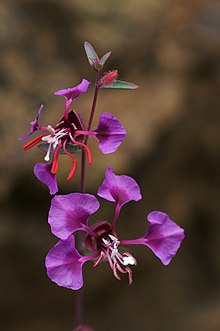Clarkia unguiculata
| Clarkia unguiculata | |
|---|---|

| |
| Scientific classification | |
| Kingdom: | Plantae |
| Clade: | Tracheophytes |
| Clade: | Angiosperms |
| Clade: | Eudicots |
| Clade: | Rosids |
| Order: | Myrtales |
| Family: | Onagraceae |
| Genus: | Clarkia |
| Species: | C. unguiculata
|
| Binomial name | |
| Clarkia unguiculata | |

| |
| Range in California | |
| Synonyms[2] | |
| |
Clarkia unguiculata is a species of wildflower known by the common name elegant clarkia or mountain garland.[3] The plant was named after Captain William Clark who was part of the Lewis and Clark Expedition.
Distribution and habitat
[edit]This plant is endemic to California, where it is found in many woodland habitats.[4] It grows along the coastal ranges of Mendocino and San Diego. Clarkia unguiculata can also be found in the Sierran foothills. Specifically, it is common on the forest floor of many oak woodlands, along with typical understory wildflowers that include Calochortus luteus, Cynoglossum grande and Delphinium variegatum.[5] It flowers in the summer and fall and thrives in somewhat neutral soil pH. Commonly found on open slopes or slightly shaded areas. [6] These slopes are below 5000 feet and have dry conditions, where the plant thrives.[7]
Description
[edit]C. unguiculata presents a spindly, hairless, waxy stem with a red hue. The species can grow up to 3 ft (0.9 m) tall with a small number of leaves populating the stem.[8] The showy flowers have hairy, fused sepals forming a cup beneath the corolla, and four petals each one to 2.5 cm (1.0 in) long.[9] The paddle-like petals come in shades of pink to reddish to purple and are slender and diamond-shaped or triangular in a raceme formation, in which each flower is connected to the main stalk by a pedicel, a short stem extension.[8] There are eight long stamens, the outer four of which have large red anthers. The stigma protrudes from the flower and can be quite large. Its pistil is a long white structure, this combined with the red stamens allow this flower to be easily identifiable.[10] The base of the stem has the leaves arranged in an opposite formation, however further up the stem the leaf arrangement becomes alternate. Produces a small indehiscent fruit, similar to a nut which hold the many little seeds.[11]
Ecology
[edit]Clarkia unguiculata is pollinated by a variety of bees, butterflies and some bats.[8] The main pollinator is Hesperapis regularis, a native species of bees found in similar environments to C. unguiculata.[12] This plant has the ability to self-pollinate.[13] This means the species is less reliant on the presence of pollinators like bees or butterflies to propagate itself.
The caterpillars of the mariposa forester feed on it.[14]
Commercial cultivars
[edit]-
'Albatross'
-
'Firebrand'
-
'Gloriosa'
-
'Lilac'
-
'Tall Double Mix'
Cultivation and Uses
[edit]This species can be cultivated in local gardens, requiring dry air and dry soil for it to bloom.[15] It can be grown in any soil condition; sand, loamy or clay soils as long as the plant remains in dry conditions. As a hermaphroditic species, being pollinated by pollinators is very easy and requires less energy from the plant. The species can not be grown in shaded areas, it must be exposed to the sun for majority of the day as it does not do well in cold conditions. If grown correctly, the seed will germinate within 2 weeks and bloom late summer and early fall.[16]
Although not typically eaten, some parts of the plant is edible, specifically the seed. The seed can be eaten raw or cooked and grounded into a fine powder.[17]
References
[edit]- ^ "Clarkia unguiculata". NatureServe.
- ^ "Clarkia unguiculata". Plants of the World Online. Royal Botanic Gardens, Kew. Retrieved 16 November 2024.
- ^ NRCS. "Clarkia unguiculata". PLANTS Database. United States Department of Agriculture (USDA). Retrieved 29 November 2019.
- ^ Calscape. "Elegant Clarkia". calscape.org. Retrieved 2024-11-16.
- ^ C. Michael Hogan. 2009. Gold Nuggets: Calochortus luteus, GlobalTwitcher.com, ed. N. Stromberg
- ^ "Clarkia unguiculata Elegant Fairyfan, Elegant clarkia PFAF Plant Database". pfaf.org. Retrieved 2024-12-05.
- ^ "Lady Bird Johnson Wildflower Center - The University of Texas at Austin". www.wildflower.org. Retrieved 2024-12-05.
- ^ a b c "Lady Bird Johnson Wildflower Center - The University of Texas at Austin". www.wildflower.org. Retrieved 2024-11-16.
- ^ Jepson Manual. 1993. Clarkia unguiculata
- ^ "Clarkia unguiculata". ucjeps.berkeley.edu. Retrieved 2024-12-05.
- ^ "Clarkia unguiculata". ucjeps.berkeley.edu. Retrieved 2024-12-05.
- ^ Peach, Kristen; Mazer, Susan J. (April 2019). "Heteranthery in Clarkia : pollen performance of dimorphic anthers contradicts expectations". American Journal of Botany. 106 (4): 598–603. doi:10.1002/ajb2.1262. ISSN 0002-9122.
- ^ Moeller, David A.; Geber, Monica A. (2005). "Ecological Context Of The Evolution Of Self-Pollination In Clarkia Xantiana: Population Size, Plant Communities, And Reproductive Assurance". Evolution. 59 (4): 786. doi:10.1554/04-656. ISSN 0014-3820.
- ^ Powell, Jerry A. & Opler, Paul A. (2009). Moths of Western North America. University of California Press, Berkeley and Los Angeles, CA. ISBN 978-0-520-25197-7
- ^ "Lady Bird Johnson Wildflower Center - The University of Texas at Austin". www.wildflower.org. Retrieved 2024-12-09.
- ^ "medicinal herbs: ELEGANT FAIRYFAN - Clarkia unguiculata". www.naturalmedicinalherbs.net. Retrieved 2024-12-09.
- ^ "Clarkia unguiculata Elegant Fairyfan, Elegant clarkia PFAF Plant Database". pfaf.org. Retrieved 2024-12-09.
External links
[edit]![]() Media related to Clarkia unguiculata at Wikimedia Commons
Media related to Clarkia unguiculata at Wikimedia Commons
- NatureServe secure species
- Clarkia
- Endemic flora of California
- Flora of the Sierra Nevada (United States)
- Natural history of the California chaparral and woodlands
- Natural history of the California Coast Ranges
- Natural history of the Peninsular Ranges
- Natural history of the Santa Monica Mountains
- Natural history of the Transverse Ranges
- Plants described in 1837
- Myrtales stubs






